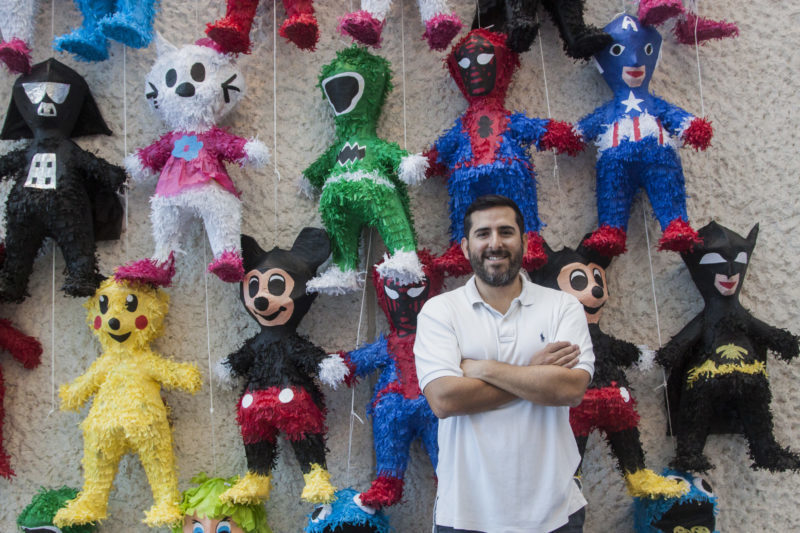Artist’s Piñatas Confront Relentless Gentrification in East Austin
By Kat Sampson
Reporting Texas

Architect and artist David Goujon with his piñata wall at the Mexican-American Cultural Center in Austin. Visitors used baseball bats to destroy his creations during the South by Southwest festival in March. Ignatius Koh / Reporting Texas
When the Jumpolin party rental and piñata store was unexpectedly demolished in early 2015, Austin architect David Goujon was ready. He secured city funding and built three giant piñatas from the debris. He’s been making piñatas ever since.
“It’s my form of protest, I guess,” Goujon, 34, said during a recent interview.
Real estate developers tore down the piñata store and its contents in February 2015. The Mexican-born couple who operated Jumpolin for over 17 years said they hadn’t been given time to remove their wares, and sued the developers. The case was settle out of court, but Jumpolin’s destruction became a symbol of gentrification in East Austin, which has historically been home to many of the city’s minorities.
As home values rise, many black and Hispanic residents have been pressured out by skyrocketing property taxes. According to Neighborhood Scout, an online real estate data firm, the median home price in East Austin is nearly $335,000, which makes it more expensive than 90 percent of Texas neighborhoods and 75 percent of all U.S. neighborhoods. The area’s homes are being replaced by newer residences, bars and cafes.
Goujon, an architect for Forge Craft Architecture and Design in Austin, uses architectural-engineering software to build public art displays that incorporate his Mexican heritage into commentary on Latino issues. He won financial support from the city’s temporary public art program, which gives artists up to $10,000 for art that encourages civic dialogue.
“I thought, ‘So they destroyed a piñata store. Now I’m going to create a piñata and I’m going to make it giant and put it in your face,’” Goujon said.
Preserving Latino culture hits close to home for Goujon, who moved with his family from Mexico to Houston when he was a boy. After earning a master’s in architecture from the University of Houston, Goujon moved to Austin, where he works as a project designer for Forge Craft. He says he has a personal focus on affordable housing and responsible development. Now married and settled in the city, Goujon says he’s grown increasingly interested in finding ways to conserve the rich Latino culture in East Austin.
“Las Piñatas” — three 10-foot-tall piñata donkeys — sat in Edward Rendon Sr. Park in East Austin between October and November 2015. The project won an award from Americans for the Arts, recognizing Goujon’s contribution to American public art.
Goujon’s latest project was a giant piñata wall — 25 piñatas wide and four piñatas tall — commissioned by the Mexican-American Cultural Center for its Casa Mexico event during the South by Southwest festival. Visitors helped destroy the wall with baseball bats.
“The thesis behind it, really, is that any wall designed to divide is only as strong as a wall of piñatas,” Goujon said. “That’s the entire point. Walls are made to be torn down.”
He said the wall is also a political commentary, “a monument of racism” worthy of destruction. Goujon says the wall was pointed at President Donald Trump’s plans to extend and reinforce the wall between Mexico and the U.S.
“You build this wall, and it’s designed to evoke fear and a feeling of exclusion,” Goujon said. “Then you do it made with piñatas and think, ‘Wait we can actually destroy this thing.’ I don’t think they’re any different. A border wall built by this administration and a wall of piñatas I see as the same thing.”
Michael Anthony García, 42, is Goujon’s friend and an artist who’s also worked as an Austin public-school reading specialist for 15 years. He says Goujon’s ability to create impressive public art is politically motivating for the Latino community.
“As people of color, our very bodies are political, our very existence in the public sphere is a political act,” García said. “By him putting his story out there and his voice, I think that’s just as important as people interacting with the piece itself.”
Art Alliance Austin, a nonprofit organization that promotes contemporary art and artists, plans to commission a Goujon piñata piece for next year’s 68th annual Art City Austin event, says Jade Walker, the alliance’s interim director. This year’s three-day festival at the end of March hosted more than 125 artists, 23 galleries and 4,000 attendees.
“[Goujon] wasn’t an artist who was like ‘Here’s my body of work and it looks like this.’” He was like, ‘This thing happened in my community and it really made me mad, and I really have to make a piece of art that speaks to this injustice in my community,” Walker said. “That’s what really stuck with me about David.”
Goujon says his support for the Latino community doesn’t just come from his art, but also his pocketbook. He says he buys dozens of piñatas for his art installations from stores like Jumpolin, whose owners now operate out of a storage shed in East Austin. Through his art and his business, Goujon says he wants his Latino neighbors to know they’re still a part of the city despite encroaching gentrification.
Goujon says he feels like he’s making the biggest impact when he can interact with his community, which he does as the chair of the Austin chapter of Latinos in Architecture. He’s also as the founder of the nonprofit Las Piñatas ATX, which started an annual piñata party at the Mexican-American Cultural Center in 2015, coinciding with Día de los Muertos, or Day of the Dead.
As he continues to make these community installations, he said turning a negative into a positive will remain the central theme.
“You see where there’s a need and there’s usually an opportunity behind that,” Goujon said. “If there are people that are really afraid, then there’s probably a way to alleviate that.”